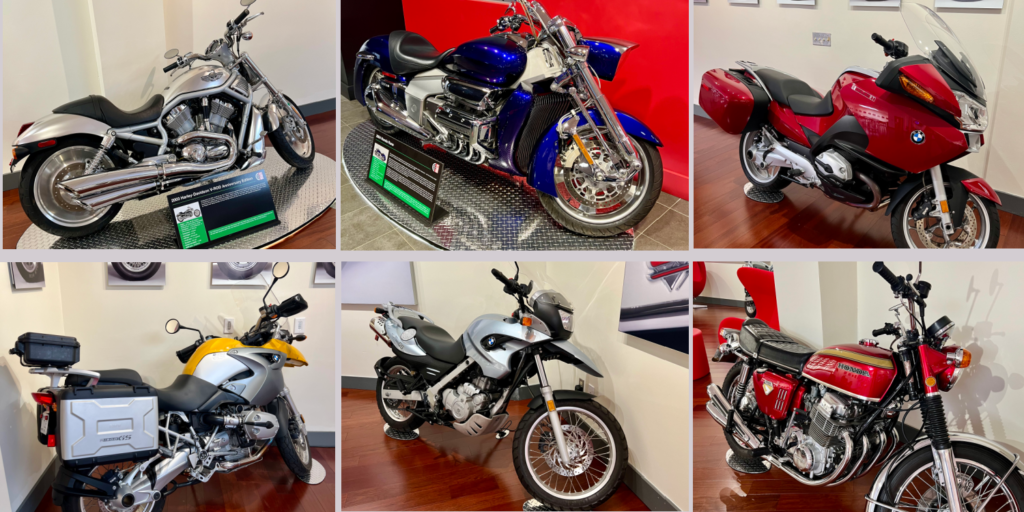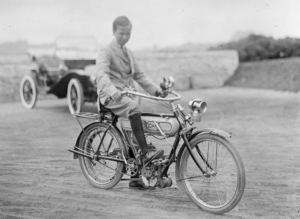28 Feb Motorcycles!

(Clockwise from top left) 2003 Harley Davison V-ROD Anniversary Edition, 2004 Honda Rune, 2005 BMW RT 1200 R, 1970 Honda CB750, 2006 BMW F 650 GS, 2005 BMW R 1200 GS
Ten new wheels have been added to the Wheel Room, the space where organizations (including motorcycle clubs) gather during special events and group visits to the Newport Car Museum. Two more wheels, in the form of a 2004 Honda Rune, greet visitors in the lobby, illustrating the fact that motorcycles have their own well–deserved place in transportation history.
Just as the automobile was the answer to the 19th-Century dream of self-propelling the horse-drawn carriage, the invention of the motorcycle created the self-propelled bicycle. The first commercial design was a three-wheeler built by Edward Butler in Great Britain in 1884. It employed a horizontal single-cylinder gasoline engine mounted between two steerable front wheels and connected by a drive chain to the rear wheel.

An early motorcycle, c. 1900. (Photo and some text excerpts from Encyclopedia Brittanica)
By 1900 many manufacturers were converting bicycles—or pedal cycles, as they were sometimes called—by adding small, centrally mounted spark ignition engines. The need for reliable constructions led to road motorcycle trial tests and competition between manufacturers.
The development of the Honda Rune can be traced back to the innovative Zodia motorcycle – with its shocking design elements – that Honda revealed at the Tokyo Motor Show back in 1995.
Before Honda introduced the Rune in 2003 (as a 2004 model), the Rune’s development team released four concept models based on the Honda Valkyrie and displayed them at motorcycle shows throughout the U.S. The second model was the overwhelming crowd favorite, and in a most unusual move, Honda produced the motorcycle virtually unchanged from the concept bike.
It is estimated that each Rune cost Honda approximately $100,000 to build. Each bike then sold for $25,000. As a limited-run motorcycle, the Honda Rune clearly wasn’t about turning a huge profit. It was a concept bike brought to life…a rolling sculpture as tractable and easy to ride as any Honda product. It was a motorcycle built by Honda just because it could.
Honda of Japan introduced the Honda CB750 motorcycle to the U.S. and European markets in 1969 after experiencing success with its smaller motorcycles. The CB750 was targeted directly at the U.S. market after Honda officials, including founder Soichiro Honda, repeatedly met with U.S. dealers and understood the opportunity for a larger bike.
The Honda CB75 has four cylinders, four megaphone exhausts, a front disk brake, overhead camshaft, and amazing fit and finish. Adding to the bike’s value were its electric starter, kill switch, dual mirrors, flashing turn signals, easily maintained valves, overall smoothness, and low vibration.
The CB75 was so revolutionary, in fact, that it overshadowed everything else in the market, and the term “superbike” was coined to describe it.
Introduced in a 2001 model line-up, the Harley-Davidson V-Rod motorcycle represents the first member of the manufacturer’s new family of Performance Custom motorcycles. It’s a tightly refined package of pure custom Harley-Davidson style and attitude backed by the performance of a Porsche designed liquid-cooled, 60◦ Revolution engine, evolved from the engine created by Porsche and Harley-Davidson for their VR1000 racing bike that raced in the AMA superbike championship.
The V-Rod truly is a work of art. From the sinuous frame that snakes around the engine to sensuous exhaust pipes and the drop-dead gorgeous paint finish, this motorcycle is unlike any Harley-Davison that has come before it.
Check out these and the 2005 BMW RT 1200 R, BMW R 1200GS, and 2006 BMW F 650 GS on your next visit to the Newport Car Museum!

